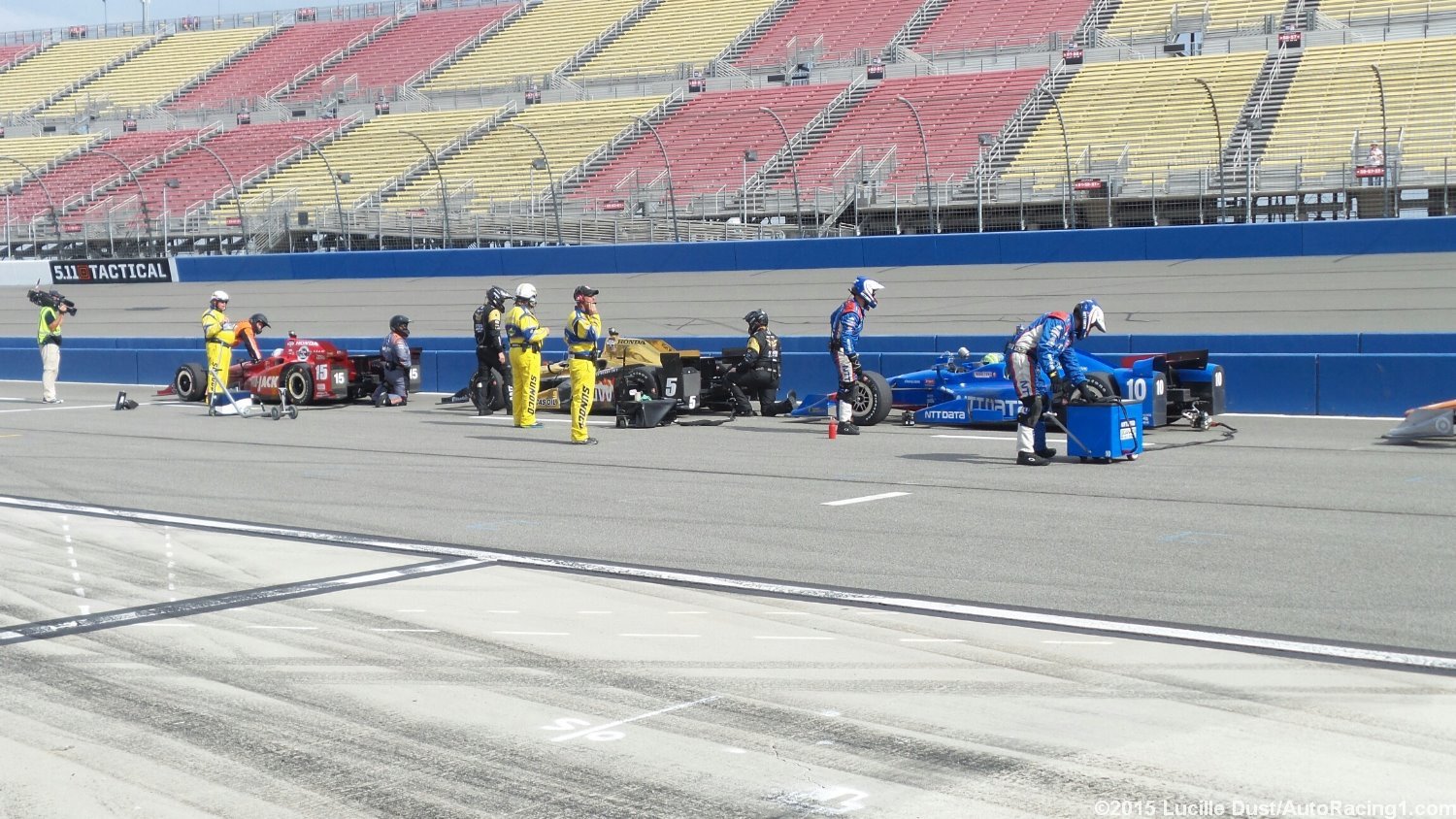Many, many race fans missed great IndyCar race, maybe last at Fontana
 |
| Red-Flag with 5 laps to go. Some idiot scheduled the Fontana race in the summer in the California desert. Most of the grandstands looked like this. |
| Lucille Dust/AR1.com |
In case you missed Saturday's Verizon IndyCar Series MAV TV 500 at Auto Club Speedway – and let's face it, that was most of you – it featured consistent good competition and a storybook finish.
How good was it? The field of 23 cars were so close at high speeds that it resembled a Saturday night program at a short track. There was a record number of lead changes (80), breaking a mark of 73 set at the very same two-mile superspeedway in 2001. It was so good the NBCSN announcers made their viewers turn down the volume to soften their screams.
And it was done without injuries. Graham Rahal ran the 250 laps at an average speed of 168.846 mph. The race was fast, but cautions in the last 10 laps slowed the race although racers were going around at more than 216 mph and at times four- and five-wide.
There were two major crashes, including one that effectively ended the race two laps from the finish as Ryan Briscoe flipped upside at the finish line and escaped injury after contact with Ryan Hunter-Reay. One incident 10 laps from the finish produced a red flag period, which prompted a five-lap sprint to the final checkered flag.
There was also good news on the weather front. Instead of the predicted temperature of 100-plus degrees, it was a rather nice day as the race started under cloudy skies at 84 degrees, although a bit humid. Perhaps it was Divine Intervention, although it would have been welcomed in 2014 when it was quite warm on a Saturday night in late August.
Fans might have enjoyed the close pack racing, but not all the drivers were in agreement.
Will Power, the 2014 series champion, called the wild day on the track “crazy, crazy, crazy." Team Penske teammate Juan Pablo Montoya agreed, saying, “Honestly, I felt it was a little bit stupid."
But old school drivers and fans enjoyed the constant action and challenging for the lead.
“I enjoyed this type of racing when I was racing," said team owner A.J. Foyt, considered by many to be among the greatest Indy car racers of all time.
So, what was the bad news?
There was a small crowd last year in stifling conditions and an even smaller one on Saturday for the first open-wheel race in Southern California in June. Had the temps equaled those of Friday, the attendance might have been even smaller, making it much easier for the bean counters but much for difficult for track officials and sponsors.
The crowd estimation, it is track policy not to announce the final number, was 20,000. There were plenty of good seats available in the grandstand and in the infield. And the drivers noticed.
“To race like that and have 5,000 (in the stands), it’s stupid," said Tony Kanaan, the 2014 winner at Fontana. It might have been exciting for (fans), but it was crazy."
Could it have been the final IndyCar race at Fontana? It might be too early for a definite answer but, very privately, there is support for that scenario. Neither track president Dave Allen or owner International Speedway Corp. are happy with the June date, preferring to return to a preferable fall event, and have made their feelings known. But is IndyCar listening?
Title sponsor MAV TV has a year left on its contract and wants to continue its association with the track and series. But if there’s no race, then what?
It was dangerous to walk anywhere on track grounds on race day without running into fingers being pointed as to who was to blame. Most of the fingers were pointed at the sanctioning body, although the track took a few hits as well.
“What does IndyCar have against Fontana?" was the leading question, followed by the comment, “This could, more than likely, kill IndyCar oval racing in Southern California."
Let’s hope not, but we can follow the logic. There’s a rich open-wheel history in this area, even greater if Long Beach is included. Four different dates in four different years is not conducive to building crowds and keep sponsors, and television, happy. In IndyCar’s first two years, the races drew 70,000. The last two haven’t been half that total.
Are TV ratings more important than a live audience? IndyCar wants to end its season by Labor Day because football, college and NFL, dominates the small screen landscape. Outside the Indianapolis 500, one needs a magnifying glass to find the ratings numbers.
So what is 30 percent of a 0.02 rating?
Certainly not enough to kill a race that has traditionally been the series-finale and drawn a good crowd, whether at Riverside International Raceway, Ontario Motor Speedway or atop the old Kaiser Steel mill site. SoCal fans have been attracted to the discipline but it’s older set feels it’s been taken for granted during uncertain economic times.
This is a major league event, with prices comparable to other such events. You don’t expect to pay the same to see the Reign as you do the Kings, or the 66ers as compared to the Angels.
This should be a community event, and it’s been years since that attitude was seen. In the end, many race fans missed a great race. Louis Brewster/DailyBulletin.com
